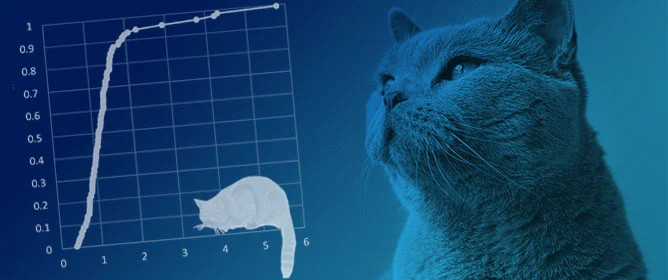

Bluecat extended to multimodel predictions.
New versions of the Bluecat software, now available in the Python environment. Jump to section of this page dedicated to the last Bluecat development.
Bluecat is a new method that Demetris Koutsoyiannis and myself recently proposed to estimate uncertainty of hydrological predictions. Bluecat comes with an open source and user friendly software to support its application. The original idea was elaborated by Demetris during his stay in Bologna in 2019. Formalisation of the method and software preparation were late as all of my working hours from February 2020 to May 2021 were absorbed by the management of the COVID19 emergency in the academia.
Bluecat is a Brisk Local Uncertainty Estimator for Deterministic Simulations and Predictions. In essence, Bluecat is a method to transform a deterministic prediction model into a stochastic prediction model, therefore turning from a point prediction to the probability distribution of the predictand. From the latter distribution, a mean (or median) prediction is obtained along with the confidence bands. In September 2024, Bluecat was extended to allow uncertainty assessment of predictions obtained with multiple alternative models (ensemble prediction), by using minimum uncertainty as a criterion for model selection.
Therefore Bluecat allows the user to performs three tasks:
- updating the deterministic prediction, therefore providing a new point prediction;
- computing confidence limits for the prediction for an assigned confidence level;
- combining predictions obtained with several alternative models by using a criterion of minimum uncertainty.
Therefore, Bluecat is not only an uncertainty assessment method: it is rather a new prediction (multi)model with a stochastic structure, and eventually a physical basis that is rooted into the deterministic model. Bluecat can be applied in conjunction with any deterministic prediction model. To provide an example of application, we refer here to rainfall-runoff modeling .

Figure 1. Conceptual scheme of Bluecat (see the Bluecat paper for details).
Bluecat is rooted in the bluprint for process-based modeling of uncertain hydrological systems proposed by Montanari and Koutsoyiannis in 2012. Here, we aim to propose an extension whose distinguishing feature is its intuitive approach that is particularly suited for technical applications.
Bluecat is introduced in a published paper that is available here.
The following papers describe applications of Bluecat:
- Koutsoyiannis, D., & Montanari, A. (2022). Climate Extrapolations in Hydrology: The Expanded Bluecat Methodology. Hydrology, 9(5), 86 (Open access).
- Rozos, E., Koutsoyiannis, D., & Montanari, A. (2022). KNN vs. Bluecat—Machine Learning vs. Classical Statistics. Hydrology, 9(6), 101 (Open access).
- Jorquera, J., & Pizarro, A. (2023). Unlocking the potential of stochastic simulation through Bluecat: Enhancing runoff predictions in arid and high‐altitude regions. Hydrological Processes, 37(12), e15046.

Figure 2. Bluecat (source: Hydrology (MDPI)).
We prepared software packages to apply Bluecat in the R and Python environments.
A first version of the software - in the R environment - applies Bluecat in conjunction with the HyMod rainfall-runoff model (Boyle, 2000). Therefore, the software includes a routine to run HyMod and optimise its parameters. The software comes with a detailed help function, along with data sets and detailed instructions to apply Bluecat to reproduce the case studies presented in the Bluecat paper. The software is open source and fully commented. Click here to access the software in GitHub.
A second version of the software was released in September 2024, to allow application of Bluecat to any deterministic model and to predictions obtained with an ensemble of models. The second version is released in the R and Python environments, again with help functions and examples of application. The software is presented in a submitted paper (click here to see a preprint).
Click here to access the R second version of the software in GitHub.
Click here to access the Python second version of the software in GitHub.
Click here to download a Powerpoint presentation of Bluecat.
Click here to download a Powerpoint presentation of Bluecat in the Italian language.
My presentation of Bluecat at the EGU22 General Assembly.
Click here to watch a video presentation of Bluecat in YouTube which uses the above Powerpoint presentation as a supporting media (actually the video shows a previous version of the Powerpoint presentation. We apologise for some spelling errors in the video presentation, that were then corrected in the presentation file that is available for download above).
Presentation of Bluecat at the EGU22 General Assembly.
A new version of Bluecat as been released in September 2024. It is described in a submitted paper that is available here. A new version of the Bluecat software has been released in the R and Python environments. Such new version stands alone, namely, it is not associated to a given deterministic model, thus allowing its association and application to any environmental model selected by the user.
Click here to access the R second version of the software in GitHub.
Click here to access the Python second version of the software in GitHub.
To allow application to multimodel prediction, we introduce a measure of uncertainty as model selection criterion to be used at each prediction step. We proposed four alternatives for such measure. Accordingly, at each prediction step uncertainty of each model is measured and the prediction - along with confidence limits - of the least uncertain model is picked up. See Figure 3.

Figure 3. Bluecat model selection procedure).
Interested users are welcome to contact us for any additional detail or suggestion.
Boyle, D. (2000). Multicriteria calibration of hydrological models (Unpublished doc- toral dissertation). Univ of Arizona, Tucson. Koutsoyiannis, D., and Montanari, A. (2021). Bluecat: A Local Uncertainty Estimator for Deterministic Simulations and Predictions, submitted manuscript. Preprint available online at http://dx.doi.org/10.13140/RG.2.2.23863.65445 (the paper provides an extended list of references). The image of the blue cat is taken from the picture available at https://www.flickr.com/photos/cizauskas/36142084534/ of the Andy Warhol exhibition at the High Museum, Atlanta, Georgia, USA (CC BY-NC-ND 4.0)
Last revised on Sept 19, 2024
- 10722 views
